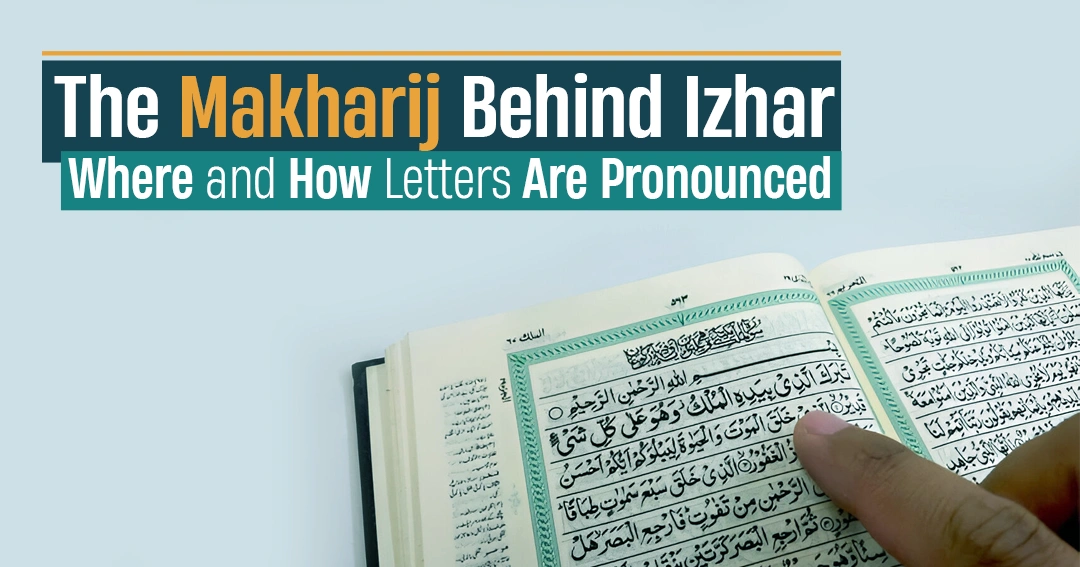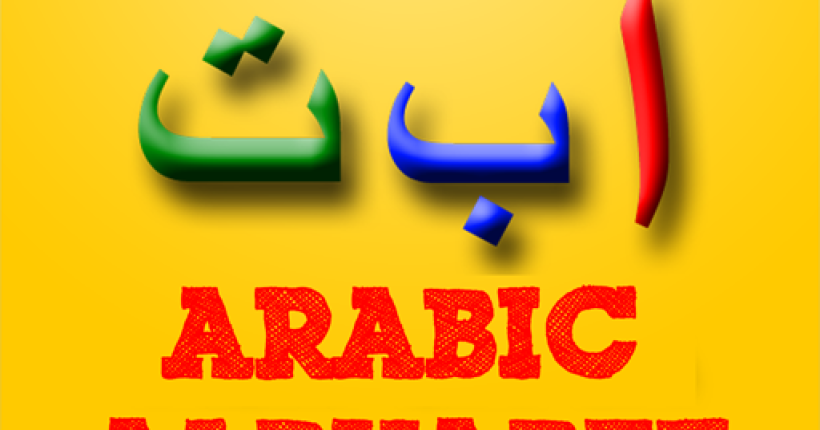Learning the Makharij of Izhar letters is essential for anyone looking to enhance their recitation of the Quran. The Izhar letters, when recited properly, bring about beauty and sophistication to your recitation, such that every word is read majestically.
Whether you are a beginner or looking to become a master in Tajweed rules, learning Izhar in Quran recitation is a step you need to take towards becoming a master of your Quranic pronunciation.
The Role of Throat Letters in Izhar Pronunciation
Every one of the six throat letters used in Izhar originates from one of three areas of the throat, upper, middle, or lower. This is where Makharij of Izhar letters really come into play.
For example, hamzah and haa come from the bottom of the throat, ‘ayn and haa from the middle, and ghayn and kha from the top throat. By knowing the origin of these letters, students can pronounce each letter with precision and clarity.
The Six Izhar Letters and Their Makharij
To use the rule of Izhar appropriately, students should be well known with the six specific letters which cause it. These letters are renowned for being pronounced clearly from the throat, an aspect that requires learning the Makharij of Izhar letters to allow for accurate recitation of the Quran.
What Are the Six Izhar Letters?

The six letters causing Izhar when coming after a Noon Saakin (نْ) or Tanween are:
ء (Hamzah)
هـ (Ha)
ع (‘Ayn)
ح (Ha)
غ (Ghayn)
خ (Kha)
These all are known as the throat letters because all of them are articulated from a specific area of the throat. Without knowing the exact Makharij of Izhar letters, it becomes hard to pronounce them correctly and clearly, which is required in order to uphold the rules of Tajweed.
The Three Makharij of the Throat Letters
Let us see in detail how the makharij of Izhar letters are categorized depending on their place in the throat:
Deepest Part of the Throat (Aqsal Halq)
ء (Hamzah) and هـ (Ha) are produced from the lowest part of the throat, closest to the chest. These sounds are breathy and must be distinct.
Middle of the Throat (Wasat al-Halq)
The Makharij of Izhar letters ع(Ayn) and ح (Ha) are from the middle of the throat region. They are soft but distinct and should be separated from nasal sounds.
Upper Throat (Adna al-Halq)
غ (Ghayn) and خ (Kha) are produced near the opening of the throat, close to the mouth. They are heavier, more forceful letters and should be modulated with finesse.
Studying these facts about the Makharij of Izhar letters gives you the ability to recite verses like a proficient Qari, clearly, confidently, and spiritually profound.
Why Knowing the Makharij of Izhar Letters Matters
Each of the six Izhar letters has a particular articulation point which, if not grasped, could lead to mispronunciation and disrupt the meaning of Quranic words.
That’s why it’s not just a case of memorizing the rules, it’s a case of applying them with full awareness of where and how each sound is being made.
Understanding the Makharij of Izhar Letters

In order to master the rule of Izhar correctly, one needs to delve deeper into studying the Makharij of Izhar letters, the places at the throat where these letters are pronounced.
Correct pronunciation of these letters leads to clarity and accuracy, and thus your recitation of the Quran becomes correct and melodious.
The Anatomy of the Throat in Relation to Izhar
The Halq, or throat, is where the articulation of all different Arabic letters, including the six Izhar letters, begins. The Makharij of Izhar letters are divided into three areas in the throat:
Aqsal Halq (Deepest Part of the Throat)
It’s the bottom part of the throat, near the chest. The letters from there are:
ء (Hamzah): It’s a sound articulated at the lowest area of the throat. It’s a short, sudden sound.
هـ (Ha): This sound is made by a breathy voice from the bottom of the throat.
Wasat al-Halq (Middle of the Throat)
The middle part of the throat is the area where these two Izhar letters are pronounced:
ع (‘Ayn): This letter is throaty, deep in sound and is formed in the middle of the throat.
ح (Ha): Softer in sound, but clearly articulated from the middle of the throat.
Adna al-Halq (Upper Throat)
These letters are produced in the upper part of the throat, close to the mouth:
غ (Ghayn): A rolling deep voice which resonates in the upper throat.
خ (Kha): Similar to Ghayn, but stronger and more rasping.
Each of them requires a unique method of expression, and therefore it is essential to learn the Makharij of Izhar letters to study Tajweed and to practice fine-tuning your recitation.
The Significance of Precise Expression
During recitation of Quranic verses, correct pronunciation of the Makharij of Izhar letters is important so that you don’t combine or confuse the letters.
For example, Noon Saakin followed by one of the Izhar letters should be correctly pronounced without any nasalization. To misplace the sound leads to confusion, altering the meaning of the verse, hence correct pronunciation from the correct part of the throat is important.
How to Practice the Makharij of Izhar Letters?

Practicing the Makharij of Izhar letters requires diligent practice and careful attention. Theory is required, but practical application is what truly makes your Tajweed stronger.
Use this step-by-step guide to practice effectively the Makharij of Izhar letters and improve your recitation of the Quran.
1. Practice Each Letter’s Makhraj Separately
Each of the six Izhar letters—ء (Hamzah), هـ (Ha), ع (‘Ayn), ح (Ha), غ (Ghayn), and خ (Kha)—requires extra attention to its makhraj, or location of articulation. To train effectively:
Practice Slowly: Practice one letter at a time. Recite it slowly, paying attention to where the sound originates in the throat.
Emphasis on Placement: As you pronounce the letter, in your mind check from which area of the throat you are saying it. Are you pronouncing it from the bottom of the throat (Aqsal Halq), the middle (Wasat al-Halq), or the top (Adna al-Halq)?
Isolate the Sound: When practicing each Izhar letter, try to say it in isolation. This avoids you confusing sounds or adding unnecessary nasalization.
2. Practice Vocal Exercises to Tighten Your Throat
Since all the Makharij of Izhar letters start in the throat, tightening your vocal muscles and mastering your breath can enhance pronunciation:
Breathing Exercises: Practice breathing exercises for good airflow while reciting. This will ensure that your voice is consistent and clear while pronouncing the letters.
Vowel Sounds: Practice long and short vowels, focusing on your breath control and smoothness of each vowel sound. This will help in the precision of Izhar letter pronunciation.
3. Practice with Common Quranic Phrases
To practice your understanding of the Makharij of Izhar letters, practice Quranic sentences which naturally have Noon Saakin or Tanween preceded by one of the six Izhar letters.
Repeating such sentences will familiarize you with the rhythm of correct pronunciation. For example:
نْ ء (Noon preceded by Hamzah)
نْ هـ (Noon preceded by Ha)
نْ غ (Noon preceded by Ghayn)
These repetitions done a number of times will not only make recitation of Makharij of Izhar letters stronger but also make your recitation more fluent.
4. Record and Listen to Your Recitation
Recording yourself while practicing can prove to be very helpful. It allows you to listen to your recitation and find out where your Makharij of Izhar letters might need improvement.
Compare your recording with someone who is an experienced Qari to find differences and make improvements.
Use Recording Apps: There are many apps dedicated to Quran recitation that allow you to record and listen to your recitation for comparison.
Listen to Professional Reciters: Listen attentively to how professional reciters accurately pronounce the Makharij of Izhar letters. This will give you an audio point of reference to compare your own recitation against.
5. Practice with a Qualified Teacher for Feedback
It’s much simpler to learn the Makharij of Izhar letters when you’re guided by experts. An expert teacher will be able to identify errors in your pronunciation and provide feedback accordingly.
The teacher will also make sure that your makharij is accurate and that you are not committing common mistakes in pronunciation.
If you are committed to mastering the Makharij of Izhar letters with accurate pronunciation, Tareequl Jannah Academy offers structured online Tajweed classes designed specifically for students of all levels.
Our experienced instructors provide you with direct, one-to-one feedback to help you pronounce these letters correctly and effectively. With their step-by-step lessons and practice sheets, you can learn at your own pace and gain the confidence needed for flawless Quran recitation.
Conclusion
Mastering Makharij of Izhar letters is of top priority in reaching your recitation of the Quran to its maximum level and allowing proper clarity within each word.
With consistency of practice, appropriate aids, and trained teaching, you are able to master Tajweed and inject beauty into the recitation. Start your journey today and experience the power of impeccable pronunciation.



